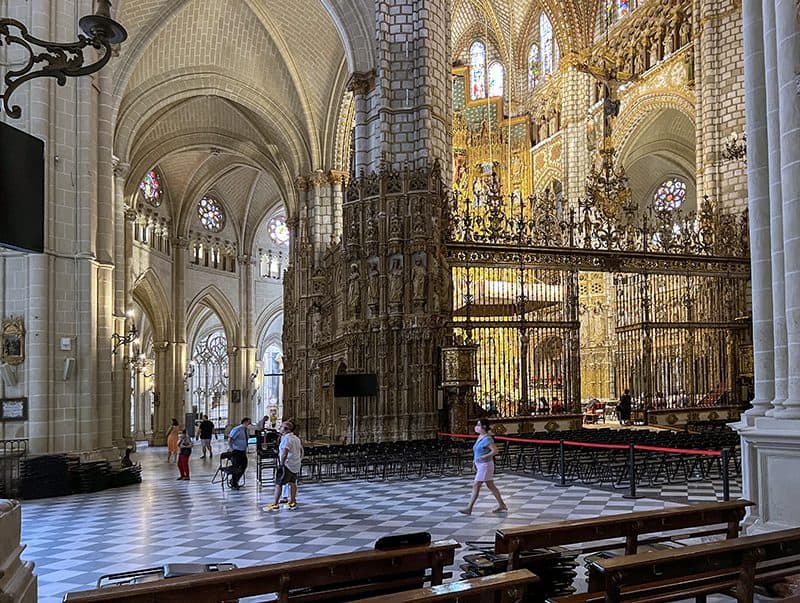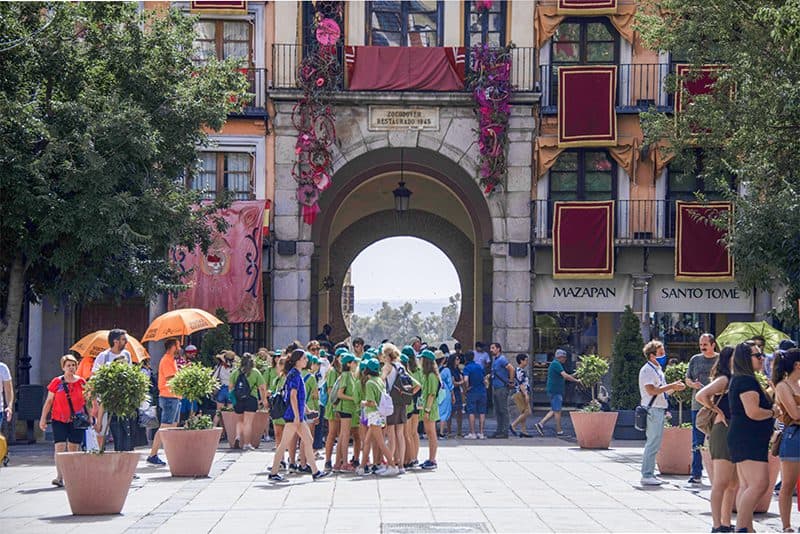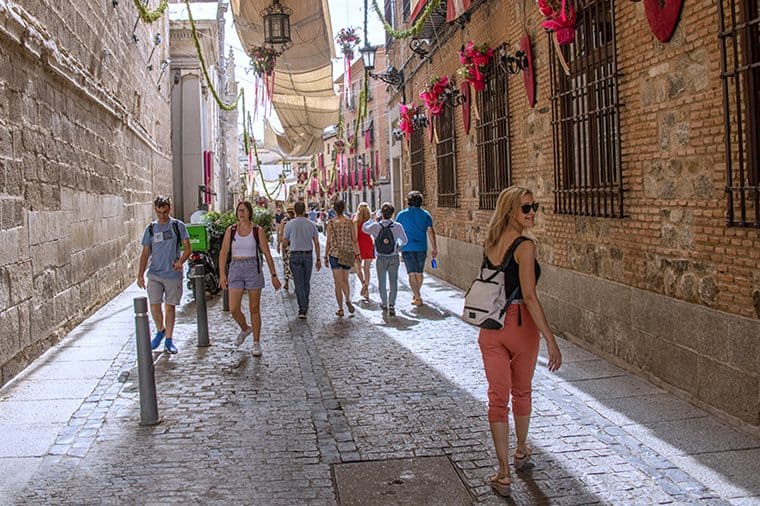Last Updated on April 4, 2024

By Jim Ferri
You hear a lot of accolades about Toledo. It’s one of the most ancient cities in Spain… it’s one of the most beautiful cities in Spain… it’s one of Spain’s great National Monuments… it’s a fantastic UNESCO World Heritage site… the list goes on and on.
But the accolade I like best is that Toledo is one of the best day trips you can take in Spain.

And here’s another: it’s only a 30-minute high-speed train ride from Madrid and an hour by car or bus from the capital.
There’s a reason Toledo attracts so much attention. Sitting majestically above the Tagus River on three sides, Toledo is an ancient cultural cornucopia. In fact, three different cultures – Christians, Muslims, and Jews – lived and worked there together for centuries.
As you might suspect the city is awash with the cultural footprints of each. In addition to the architectural beauty they’ve left behind, this cultural grupo de tres also bequeathed the most confusing medieval street plan in Spain. Nevertheless, it’s still a fascinating and adventurous place to wander about.

Toledo’s Roman Roots
Toledo can trace its roots to the Roman occupation circa 200BC. Following the Romans were the Visigoths, one of the most important of the Germanic people, and later the Muslims.
The Christians arrived in 1085 and made Toledo the capital of Spain. During the 12th and 13th centuries, Jews became Toledo’s most populous religious group. Most noteworthy is that for centuries, Jews, Christians, and Muslims coexisted peacefully in the city.
Although in the 16th century, the national capital was moved to Madrid, the city remained a remarkable aggregate of the three cultures. And you still find this aggregate, especially from an architectural perspective, very much in evidence in the city today.
Today’s Toledo is a beautiful and fascinating medieval city and a wonderful place to enjoy a day trip from Madrid. Or, perhaps, a place to spend a few days or more. But first, you need to get there.

How to Take A Toledo From Madrid Day Trip By High-Speed Train
Although buses run between Madrid and Toledo ($7-11 one way), the fastest and most comfortable way to get to Toledo from Madrid is via the AVE high-speed train. The trip is 32 minutes, and trains depart from Madrid’s Atocha Station, the city’s largest station. Reservations are necessary.
On weekdays the first train departure is around 06:50 (6:50am), the last is typically about 21:50 (9:50pm). On Saturdays and Sundays, departures start about two hours later, around 08:50 (8:50am), with the last train leaving at about 21:50 (9:50pm). Service is frequent, with about 14 departures per day, leaving approximately every 55 minutes.
The fare is approximately $15 one way if you book in advance. However, purchasing train tickets on the same day is not only more expensive, but you may also find no seats are available on this popular route. And unless you’re familiar with the station’s ticket vending machines, buying train tickets at a manned ticket booth is better.
You’ll need to go through a security scan at Atocha Station, so be at the station at least 15 minutes before departure. And also, be aware that trains close their doors five minutes before departure.
On arrival at Toledo’s station, take the blue city bus #5, 22, 61, or 62 to the last stop, Plaza Zocodover (fare is €1.60). (Red buses are privately owned and charge €2.50 for the trip.) Plaza Zocodover is the principal city square and is in the heart of the city.
For your return trip the last train departs approximately at 21:30 (9:30pm). If you decide to stay overnight, the earliest train to Madrid departs Toledo about 06:25 (6:25am). On the weekends, the first train of the day leaves Toledo at approximately 09:25 (9:25am), and the last departure is at 21:30 (9:30pm).
If You Go:
Rail Europe
https://www.raileurope.com

Best Things To See on Your Toledo From Madrid Getaway
As you might expect, given the history of Toledo, there’s an overabundance of things to see in the city. Since it was home to Jews, Christians, and Muslims, all coexisting with one another, the city was a melting pot of culture.
There’s a lot to see and do here; what you may want to see in one day can typically take several. So it’s best to see only the best of Toledo, and you’ll need to stick to a schedule on this trip from Madrid.
However, remember that given the city’s medieval warren of streets, it can be a bit confusing to wander about. But, on the other hand, it’s that very warren that makes the old city so appealing.
On the other hand, to make the best use of your time (and not get lost) you may want to consider taking a guided tour.
All this means you need to plan in advance. To help you with that planning, here are the best things to see and do in this beautiful city.

Toledo Cathedral
Toledo’s magnificent cathedral is by far the most popular site in the city. It is the best example of gothic architecture in all of Spain and, in a word, is “spectacular.”
The Toledo cathedral had been a Visigoth temple in the 6th century before a Muslim mosque was built atop it. Then, in 1226, Spain’s Catholic King and the city’s archbishop began constructing today’s cathedral atop the mosque. 15 chapels and a nave were completed by 1300, but construction continued for another two centuries.
Today the cathedral that rises above the surrounding medieval neighborhood is beautiful beyond belief. Its jaw-dropping interior is full of beautiful wood carvings, spectacular wrought iron, and 500-year-old stained-glass windows.
Spanish, Flemish, and French artists crafted its golden altar (gold on wood). In the sacristy, you’ll find masterpieces not only by local boy El Greco (18 in all!) but also by such masters including Peter Paul Rubens, Titian, Francisco de Goya, Giovanni Bellini, and others.
In its bell tower is a massive 20-ton bell, the largest in Spain. It’s known as “Campana Gorda,” and just putting it in the tower was a marvel of engineering.
Since there is so much to see here, you may want to join a guided tour for an hour. You’ll find many advertised online.
If You Go:
Toledo Cathedral
Calle Cardenal Cisneros, 1
45002 Toledo
https://www.catedralprimada.es/
@ [email protected]
Tel: 00 34 925 222 241
General Admission: €12,50

Alcazar / Army Museum
The Alcázar is a vast square building on the periphery of the old city. It stands atop the highest point in town, which was also selected as a fortress site by the Romans, Visigoths, and Moors.
The structure was damaged by fires on three separate occasions before being nearly destroyed in the Spanish Civil War. However, it was restored following the original construction plans.
The building is now the home of the National Museum of the Army, which was transferred to Toledo from Madrid, making it Spain’s main army museum.
It is also home to the 100,000 16th-19th century books and manuscripts of the Borbón-Lorenzana Library.
If You Go:
Alcázar
C/ Unión, s/n
45001 Toledo
https://www.spain.info/en/places-of-interest/alcazar-toledo/
@ [email protected]
Tel: +34 925 238 800 / +34 925 238 915
General Admission: €5

Santa Cruz Museum
Housed in a 16th-century hospital and convent, the Santa Cruz Museum contains medieval and Renaissance paintings, sculptures, and tapestries. It’s also a venue that hosts major temporary exhibitions.
The museum is also home to an outstanding collection of works by El Greco. The most notable is the altarpiece Assumption of Mary, completed one year before the artist’s death. It is considered one of El Greco’s greatest masterpieces, his “aesthetic testament” that synthesizes all his work to date.
If You Go:
El Museo de Santa Cruz
Calle Miguel de Cervantes, 3
45001, Toledo
https://cultura.castillalamancha.es/museos/nuestros-museos/museo-de-santa-cruz
@ [email protected]
Tel: 925 22 14 02
General Admission: €4

Monasterio de San Juan de los Reyes
A Monastery in the Jewish Quarter of Toledo, Monasterio de San Juan de los Reyes was built during the reign of Isabella I for two reasons.
The first was to memorialize the victory of the armies of Isabella and Ferdinand at the Battle of Toros. The second was to be a royal mausoleum for the King and Queen. However, upon their armies’ conquest of Granada, they decided to be interred there instead.
Nevertheless, the monastery is still worth a visit. See its Gothic cloister with its multi-colored Mudéjar ceiling. And the building itself is an excellent example of the Isabelline style of architecture. Also called Isabelline Gothic, it was in vogue during the monarch’s reign.
If You Go:
Monastery of San Juan de los Reyes
Calle Reyes Católicos, 17
45002 Toledo
https://www.sanjuandelosreyes.org/en/welcome-to-san-juan-de-los-reyes/
@ [email protected]
Tel: +34 925 223 802
General Admission: €3

El Greco Museum
The El Greco Museum is only a 10-minute walk from the monastery. It is also a fitting homage to one of the world’s great artists. Originally from Crete and trained in Venice, he moved to Madrid and later to Toledo. He was given the name “El Greco” (the Greek) after friends found it near-impossible to pronounce his Greek name, Doménikos Theotokópoulos.
The small, intimate museum is a beautiful place with a comprehensive collection of El Greco’s works. One of the most famous is his “View of Toledo,” commissioned after the King and national government moved to Madrid.
The museum is quite straightforward so a guided tour is not necessary.
If You Go:
Museo del Greco
Paseo del Tránsito, s/n
45002 Toledo
https://www.culturaydeporte.gob.es/mgreco/inicio.html
@ [email protected]
Tel: 925 99 09 82
General Admission: €3

Iglesia de Santo Tomé
In the Iglesia de Santo Tomé you’ll find another of El Greco’s masterpieces, The Burial of the Count of Orgaz. Santo Tomá is close to the El Greco Museum, only about a three-minute walk.
Thought to date from the 11th century, the church has a beautiful gilded interior. Its tower is also an excellent example of ancient Mudéjar architecture.
If You Go:
Iglesia de Santo Tomé
Pl. del Conde, 4
45002 Toledo
https://toledomonumental.com/monumentos/santo-tome/
@ [email protected]
Tel: (34) 925 256 098
General Admission: €3

Sinagoga del Tránsito / Museum Sefarí
Just a two-minute walk further is a 14th-century former synagogue, Sinagoga del Tránsito. It’s one of only two remaining pre-16th-century synagogues. The simple façade of the building hides what has been described as the most elaborate Mudéjar interior in Toledo.
The frieze of its prayer hall is also a fusion of Hebrew, Gothic, and Islamic motifs. In addition, it’s also the home of a museum of Sephardi (Spanish-Jewish) culture. It contains items before and after the Jews’ expulsion from Spain in the 15th century.
If You Go:
Sinagoga del Tránsito
Calle Samuel Leví s/n
45002 Toledo
https://www.culturaydeporte.gob.es/msefardi/home.html
@ [email protected]
Tel: +34 925 223 665
General Admission: €3

Plaza de Zocodover
The main square of old Toledo, Plaza de Zocodover, is the city’s heart for locals and visitors. The word “Zocodover” means “place of animals,” and centuries ago, the Plaza was an Arabian market. During the Muslim era, the old cattle market was located here near the old city walls.
Over the centuries, it’s hosted many other events, including fiestas, bullfights, and executions, although today, things are a bit tamer. Plaza de Zocodover is now a place to catch a bus, grab a bite, or just sit back and relax.
The Plaza is in the northeast area of the old city, not far from the Alcazar.

Wander About the Old City
Toledo, more than most other cities, the old city of Toledo is a place to just ramble aimlessly. Its medieval heritage makes maps somewhat useless except for the major tourist sites.
Just face the fact that you’re likely going to get lost. But that’s not such a terrible thing in Toledo.
Just remember that the Plaza de Zocodover and the Alcazar occupy the city’s high ground. If you become disoriented (aka “lost”), just walk up any street that goes uphill, and you’ll come to the Plaza.
And it won’t take you very long since the city’s old area only takes about 45 minutes to completely walk across.

Leave a Reply